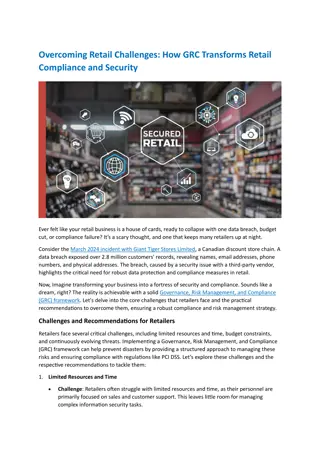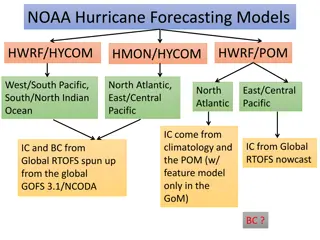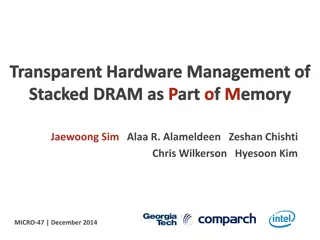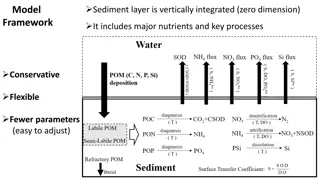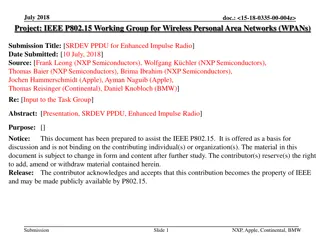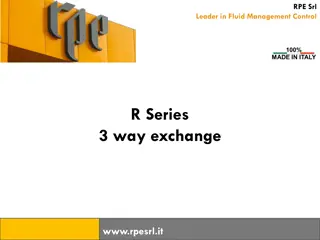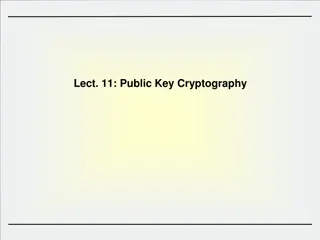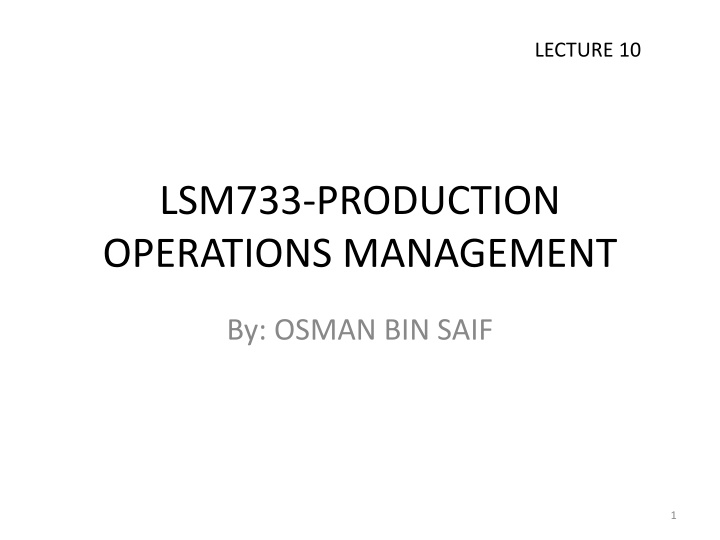
Strategies and Tools in Production Operations Management
Explore tools like Check Sheets, Scatter Diagrams, and Cause-and-Effect Diagrams in Production Operations Management alongside insights into process strategies and technology advancements for better efficiency.
Download Presentation

Please find below an Image/Link to download the presentation.
The content on the website is provided AS IS for your information and personal use only. It may not be sold, licensed, or shared on other websites without obtaining consent from the author. If you encounter any issues during the download, it is possible that the publisher has removed the file from their server.
You are allowed to download the files provided on this website for personal or commercial use, subject to the condition that they are used lawfully. All files are the property of their respective owners.
The content on the website is provided AS IS for your information and personal use only. It may not be sold, licensed, or shared on other websites without obtaining consent from the author.
E N D
Presentation Transcript
LECTURE 10 LSM733-PRODUCTION OPERATIONS MANAGEMENT By: OSMAN BIN SAIF 1
Summary of Last Session Tools of TQM Check Sheets Scatter Diagrams Cause-and-Effect Diagrams Pareto Charts Flowcharts Histograms Statistical Process Control (SPC) 2
Summary of Last Session (Contd.) The Role of Inspection When and Where to Inspect Source Inspection Service Industry Inspection Inspection of Attributes versus Variables TQM in Services 3
Summary of Last Session (Contd.) Tools for Generating Ideas Check sheets Scatter diagrams Cause-and-effect diagrams Tools to Organize the Data Pareto charts Flowcharts Tools for Identifying Problems Histogram Statistical process control chart 4
Agenda for this session Four Process Strategies Process Focus Repetitive Focus Product Focus Mass Customization Focus Comparison of Process Choices Process Analysis and Design Flow Diagrams Time-Function Mapping Value-Stream Mapping Process Charts Service Blueprinting 5
Agenda for this session (Contd.) Service Process Design Customer Interaction and Process Design More Opportunities to Improve Service Processes Selection of Equipment and Technology Production Technology Machine Technology Automatic Identification Systems (AISs) and RFID Process Control Vision Systems Robots 6
Agenda for this session (Contd.) Production Technology (cont.) Automated Storage and Retrieval Systems (ASRSs) Automated Guided Vehicles (AGVs) Flexible Manufacturing Systems (FMSs) Computer-Integrated Manufacturing (CIM) Technology in Services Process Redesign Ethics and Environmentally Friendly Processes 7
Comparison of Processes Process Focus (Low volume, high variety) Repetitive Focus (Modular) Product Focus (High-volume, low-variety) Mass Customization (High-volume, high-variety) Small quantity, large variety of products Long runs, standardized product made from modules Large quantity, small variety of products Large quantity, large variety of products General purpose equipment Special equipment aids in use of assembly line Special purpose equipment Rapid changeover on flexible equipment Table 7.2 8
Comparison of Processes Process Focus (Low volume, high variety) Repetitive Focus (Modular) Product Focus (High-volume, low-variety) Mass Customization (High-volume, high-variety) Operators are broadly skilled Employees are modestly trained Operators are less broadly skilled Flexible operators are trained for the necessary customization Many job instructions as each job changes Repetition reduces training and changes in job instructions Few work orders and job instructions because jobs standardized Custom orders require many job instructions Table 7.2 9
Comparison of Processes Process Focus (Low volume, high variety) Repetitive Focus (Modular) Product Focus (High-volume, low-variety) Mass Customization (High-volume, high-variety) Raw material inventories high JIT procurement techniques used Raw material inventories are low Raw material inventories are low Work-in- process is high JIT inventory techniques used Work-in- process inventory is low Work-in- process inventory driven down by JIT, lean production Table 7.2 10
Comparison of Processes Process Focus (Low volume, high variety) Repetitive Focus (Modular) Product Focus (High-volume, low-variety) Mass Customization (High-volume, high-variety) Units move slowly through the plant Movement is measured in hours and days Swift movement of unit through the facility is typical Goods move swiftly through the facility Finished goods made to order Finished goods made to frequent forecast Finished goods made to forecast and stored Finished goods often build-to-order (BTO) Table 7.2 11
Comparison of Processes Process Focus (Low volume, high variety) Repetitive Focus (Modular) Product Focus (High-volume, low-variety) Mass Customization (High-volume, high-variety) Scheduling is complex, trade-offs between inventory, availability, customer service Scheduling based on building various models from a variety of modules to forecasts Relatively simple scheduling, establishing output rate to meet forecasts Sophisticated scheduling required to accommodate custom orders Table 7.2 12
Comparison of Processes Process Focus (Low volume, high variety) Repetitive Focus (Modular) Product Focus (High-volume, low-variety) Mass Customization (High-volume, high-variety) Fixed costs low, variable costs high Fixed costs dependent on flexibility of the facility Fixed costs high, variable costs low Fixed costs high, variable costs must be low Costing estimated before job, known only after the job Costs usually known due to extensive experience High fixed costs mean costs dependent on utilization of capacity High fixed costs and dynamic variable costs make costing a challenge Table 7.2 13
Crossover Charts Variable costs Variable costs Variable costs $ $ $ Fixed costs Fixed costs Fixed costs Repetitive Process B High volume, low variety Process C Low volume, high variety Process A $ 400,000 300,000 200,000 Fixed cost Process A Fixed cost Process B Fixed cost Process C Figure 7.6 V1 V2(6,666) (2,857) Volume 14
Focused Processes Focus brings efficiency Focus on depth of product line rather than breadth Focus can be Customers Products Service Technology 15
Changing Processes Difficult and expensive May mean starting over Process strategy determines transformation strategy for an extended period Important to get it right 16
Process Analysis and Design Flow Diagrams - Shows the movement of materials Time-Function Mapping - Shows flows and time frame Value-Stream Mapping - Shows flows and time and value added beyond the immediate organization Process Charts - Uses symbols to show key activities Service Blueprinting - focuses on customer/provider interaction 17
Baseline Time-Function Map Order product Receive product Customer Process order Sales Production control Wait Plant A Print Warehouse Wait Wait Wait Extrude Plant B Move Move Transport 12 days 13 days 1 day 4 days 1 day 10 days 1 day 0 day 1 day Figure 7.7 52 days 18
Target Time-Function Map Order product Receive product Customer Process order Sales Production control Wait Plant Print Extrude Warehouse Wait Transport Move 1 day 2 days 1 day 1 day 1 day 6 days Figure 7.7 19
Value-Stream Mapping Figure 7.8 20
Process Chart Figure 7.9
Service Blueprint Focuses on the customer and provider interaction Defines three levels of interaction Each level has different management issues Identifies potential failure points 22
Service Blueprint Personal Greeting Service Diagnosis Perform Service Friendly Close Level #1 Customer arrives for service Customer departs F Customer pays bill Notify customer and recommend an alternative provider Determine specifics Warm greeting and obtain service request No F Standard request Can Level #2 F service be done and does customer approve? No Direct customer to waiting room Notify customer the car is ready F F F Yes Yes Perform required work Level #3 F Prepare invoice Figure 7.10 F 23
Process Analysis Tools Flowcharts provide a view of the big picture Time-function mapping adds rigor and a time element Value-stream analysis extends to customers and suppliers Process charts show detail Service blueprint focuses on customer interaction
Service Process Matrix Degree of Customization High Low Mass Service Professional Service Private banking Commercial banking General- High purpose law firms Full-service stockbroker Degree of Labor Boutiques Retailing Service Factory Service Shop Specialized hospitals Law clinics Limited-service stockbroker Fine-dining restaurants Warehouse and catalog stores Fast-food restaurants Hospitals Low Airlines No-frills airlines Figure 7.11 25
Service Process Matrix Mass Service and Professional Service Labor involvement is high Selection and training highly important Focus on human resources Personalized services Service Factory and Service Shop Automation of standardized services Low labor intensity responds well to process technology and scheduling Tight control required to maintain standards 26
Improving Service Productivity Strategy Technique Example Separation Structure service so customers must go where service is offered Bank customers go to a manager to open a new account, to loan officers for loans, and to tellers for deposits Self-service Self-service so customers examine, compare, and evaluate at their own pace Supermarkets and department stores, Internet ordering Table 7.3 27
Improving Service Productivity Strategy Technique Example Postponement Customizing at delivery Customizing vans at delivery rather than at production Focus Restricting the offerings Limited-menu restaurant Modules Modular selection of service, modular production Investment and insurance selection, prepackaged food modules in restaurants Table 7.3 28
Improving Service Productivity Strategy Technique Example Automation Separating services that may lend themselves to automation Automatic teller machines Precise personnel scheduling Scheduling Scheduling ticket counter personnel at 15-minute intervals at airlines Clarifying the service options, explaining how to avoid problems Training Investment counselor, funeral directors, after- sale maintenance personnel Table 7.3 29
Improving Service Processes Layout Product exposure, customer education, product enhancement Human Resources Recruiting and training Impact of flexibility 30
Equipment and Technology Often complex decisions Possible competitive advantage Flexibility Stable processes May allow enlarging the scope of the processes 31
Production Technology Machine technology Automatic identification systems (AISs) Process control Vision system Robot Automated storage and retrieval systems (ASRSs) Automated guided vehicles (AGVs) Flexible manufacturing systems (FMSs) Computer-integrated manufacturing (CIM) 32
Machine Technology Increased precision Increased productivity Increased flexibility Improved environmental impact Reduced changeover time Decreased size Reduced power requirements 33
Automatic Identification Systems (AISs) Improved data acquisition Reduced data entry errors Increased speed Increased scope of process automation Example Bar codes and RFID 34
Process Control Increased process stability Increased process precision Real-time provision of information for process evaluation Data available in many forms 35
Vision Systems Particular aid to inspection Consistently accurate Never bored Modest cost Superior to individuals performing the same tasks 37
Robots Perform monotonous or dangerous tasks Perform tasks requiring significant strength or endurance Generally enhanced consistency and accuracy 38
Automated Storage and Retrieval Systems (ASRSs) Automated placement and withdrawal of parts and products Reduced errors and labor Particularly useful in inventory and test areas of manufacturing firms 39
Automated Guided Vehicle (AGVs) Electronically guided and controlled carts Used for movement of products and/or individuals 40
Flexible Manufacturing Systems (FMSs) Computer controls both the workstation and the material handling equipment Enhance flexibility and reduced waste Can economically produce low volume at high quality Reduced changeover time and increased utilization Stringent communication requirement between components 41
Computer-Integrated Manufacturing (CIM) Extension of flexible manufacturing systems Backwards to engineering and inventory control Forward into warehousing and shipping Can also include financial and customer service areas Reducing the distinction between low- volume/high-variety, and high-volume/low- variety production 42
Computer- Integrated Manufacturing (CIM) Figure 7.12 43
Technology in Services Service Industry Example Financial Services Debit cards, electronic funds transfer, ATMs, Internet stock trading Education Electronic bulletin boards, on-line journals, WebCT and Blackboard Utilities and government Automated one-man garbage trucks, optical mail and bomb scanners, flood warning systems Restaurants and foods Wireless orders from waiters to kitchen, robot butchering, transponders on cars that track sales at drive-throughs Communications Electronic publishing, interactive TV 44 Table 7.4
Technology in Services Service Industry Example Hotels Electronic check-in/check-out, electronic key/lock system ATM-like kiosks, point-of-sale (POS) terminals, e-commerce, electronic communication between store and supplier, bar coded data Wholesale/retail trade Transportation Automatic toll booths, satellite-directed navigation systems Health care Online patient-monitoring, online medical information systems, robotic surgery Airlines Ticketless travel, scheduling, Internet purchases 45 Table 7.4
Process Redesign The fundamental rethinking of business processes to bring about dramatic improvements in performance Relies on reevaluating the purpose of the process and questioning both the purpose and the underlying assumptions Requires reexamination of the basic process and its objectives Focuses on activities that cross functional lines Any process is a candidate for redesign 46
Ethics and Environmentally Friendly Processes Reduce the negative impact on the environment Encourage recycling Efficient use of resources Reduction of waste by-products Use less harmful ingredients Use less energy 47
Summary of this session Four Process Strategies Process Focus Repetitive Focus Product Focus Mass Customization Focus Comparison of Process Choices Process Analysis and Design Flow Diagrams Time-Function Mapping Value-Stream Mapping Process Charts Service Blueprinting 48
Summary of this session (Contd.) Service Process Design Customer Interaction and Process Design More Opportunities to Improve Service Processes Selection of Equipment and Technology Production Technology Machine Technology Automatic Identification Systems (AISs) and RFID Process Control Vision Systems Robots 49
Summary of this session (Contd.) Production Technology (cont.) Automated Storage and Retrieval Systems (ASRSs) Automated Guided Vehicles (AGVs) Flexible Manufacturing Systems (FMSs) Computer-Integrated Manufacturing (CIM) Technology in Services Process Redesign Ethics and Environmentally Friendly Processes 50

